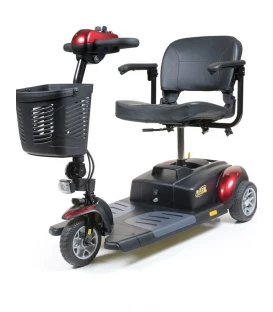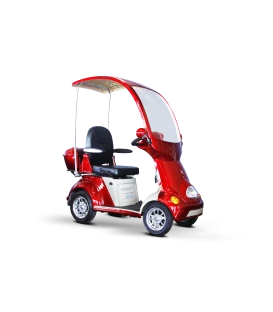3-Wheel Mobility Scooters vs. 4-Wheel Mobility Scooters

Mobility scooters have become indispensable tools for individuals with limited mobility, allowing them to regain independence and navigate their surroundings with ease. When considering a mobility scooter, one of the key decisions is choosing between a 3-wheel and a 4-wheel model. Each option has its unique advantages and considerations that can significantly impact the user's experience. In this article, we will explore the differences between 3-wheel and 4-wheel mobility scooters, helping readers make an informed choice.
-
Maneuverability and Turning Radius: One of the primary distinctions between 3-wheel and 4-wheel mobility scooters lies in their maneuverability and turning radius. 3-wheel scooters are known for their exceptional maneuverability, making them ideal for navigating tight indoor spaces, crowded areas, and narrow hallways. The single front wheel allows for sharper turns and greater agility. On the other hand, 4-wheel scooters offer enhanced stability due to their wider wheelbase, making them more suitable for outdoor terrains and uneven surfaces. The four-wheel configuration provides a smoother ride and improved stability during sharp turns.
-
Stability and Balance: While maneuverability is important, stability and balance are crucial factors to consider when selecting a mobility scooter. 4-wheel scooters, with their wider wheelbase and evenly distributed weight, offer superior stability. This feature makes them an excellent choice for users who prioritize a stable and secure ride, especially on uneven surfaces and inclines. In contrast, 3-wheel scooters have a narrower wheelbase, which may make them slightly less stable. However, modern 3-wheel models often come equipped with advanced stability features, such as anti-tip mechanisms, to mitigate this concern.
-
Weight Capacity and Load Distribution: Another significant consideration when choosing a mobility scooter is the weight capacity and load distribution. Generally, 4-wheel scooters tend to have a higher weight capacity due to their broader base, which enables them to accommodate heavier individuals and carry more substantial loads. The even weight distribution on all four wheels further contributes to the scooter's stability. 3-wheel scooters typically have a lower weight capacity but are still suitable for many users with average mobility needs.
-
Indoor vs. Outdoor Usage: The intended usage of the mobility scooter plays a vital role in determining the most suitable model. 3-wheel scooters are designed with indoor maneuverability in mind. Their compact size, tight turning radius, and narrow profile make them ideal for navigating through doorways, corridors, and confined spaces. In contrast, 4-wheel scooters offer increased stability and robustness, making them well-suited for outdoor use. With their larger wheels and more powerful motors, they can handle rough terrains, gravel paths, and uneven surfaces more effectively.
-
Transportation and Portability: Transportation and portability are crucial factors to consider, especially for individuals who frequently travel with their mobility scooters. 3-wheel scooters generally have a more compact and lightweight design, making them easier to disassemble, store, and transport. They are often preferred for users who need to transport their scooters in car trunks or on public transportation. 4-wheel scooters, while bulkier, offer added stability during transportation and may be better suited for users who primarily use their scooters within a limited area.
-
Aesthetics and Personal Preferences: Personal preferences and aesthetics can also influence the choice between a 3-wheel and 4-wheel scooter. Some users find the sleek and modern design of 3-wheel scooters appealing, while others prefer the more robust and traditional appearance of 4-wheel models. It is essential to consider personal comfort and style when selecting a mobility scooter as it can positively impact the user














